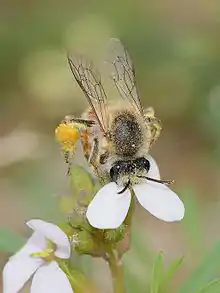Melittinae
Melittinae is a small melittid subfamily, with some 60 species in four genera, restricted to Africa and the northern temperate zone. They are typically small to moderate-sized bees, which often have shaggy scopae, and are commonly oligolectic; several species further specialize on floral oils as larval food rather than pollen, including Rediviva emdeorum, a highly unusual species in which the forelegs are longer than the entire body, and used to sponge up the floral oil at the end of elongated corolla spurs of the host plant, Diascia.[1]
| Melittinae | |
|---|---|
 | |
| Melitta maura, female | |
| Scientific classification | |
| Kingdom: | |
| Phylum: | |
| Class: | |
| Order: | |
| Suborder: | |
| Superfamily: | |
| Family: | |
| Subfamily: | Melittinae |
| Genera | |
The Melittinae are known from a fossil of Palaeomacropis eocenicus in the Early Eocene of Oise, France.[2]
References
- C. D. Michener (2000) The Bees of the World, Johns Hopkins University Press.
- Michez, Denis; Nel, Andre; Menier, Jean-Jacques; Rasmont, Pierre (2007). "The oldest fossil of a melittid bee (Hymenoptera: Apiformes) from the early Eocene of Oise (France)" (PDF). Zoological Journal of the Linnean Society. 150 (4): 701–709. doi:10.1111/j.1096-3642.2007.00307.x.
External links
This article is issued from Wikipedia. The text is licensed under Creative Commons - Attribution - Sharealike. Additional terms may apply for the media files.